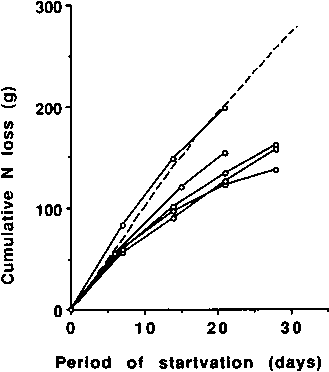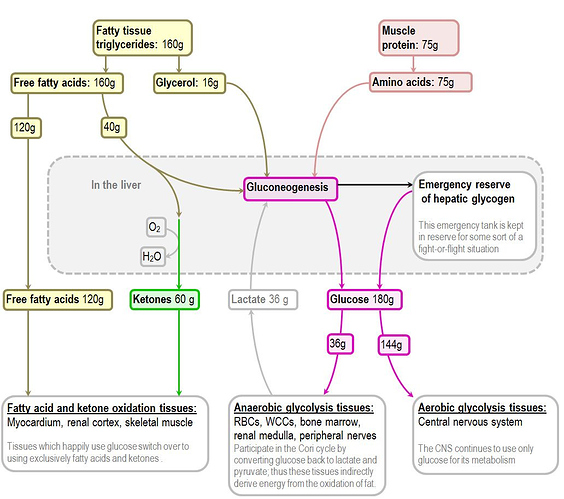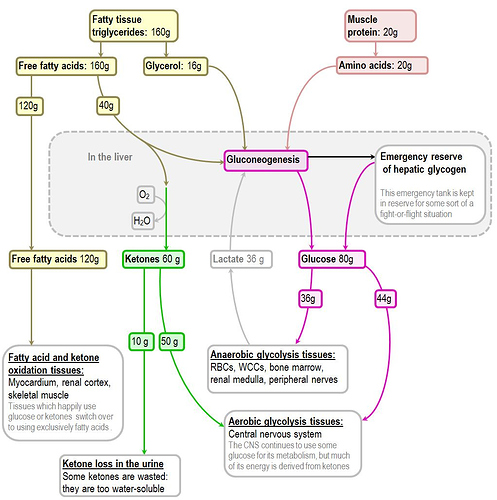I edited it your post to cue the video up to Rod Taylors’s question on fasting.
Dr  has previously said that fasting consumes 0.75 lbs of muscle per day to keep the brain alive, but that would require a very specific and unlikely context.
has previously said that fasting consumes 0.75 lbs of muscle per day to keep the brain alive, but that would require a very specific and unlikely context.
I should start my mentioning that the liver makes glucose from all available substrates, which includes lactate coming back from fermenters like red blood cells, and glycerol as a result of lipolysis, and finally the pool of labile amino acids. That’s the stuff that is circulating (eg free amino acids, or lipoproteins such as albumin), sitting in structures pending catabolism (eg: the extracellular matrix of collagen that is always reconfigured as body fat is drawn down), and proteins undergoing turnover. The Labile pool is about 1% of our total lean body mass … it is normally refilled from dietary. Once that runs dry the body will keep the brain alive by using other sources starting with those least likely to impact immediate survival. Muscle and bone are on the list … but they’re not going to be first cab off the rank.
So let’s look at the fuel flow during fasting. This is a model of the energy flow of a human on day 1 of a fast from George Cahills starvation in man
After about 8 days of fasting the brain switched from running on glucose (from diet, then for 24 hours from glycogen, then for about 7 days from gluconeogenesis) to running mostly on ketones with a small residual requirement of glucose.
NB: for someone who is adapted to a ketogenic diet … we start our fast from the 8 day mark, because we are already in that state where our brains can run mostly on ketones.
The model after the brain adapts to running on ketones looks more like this;
Now bear in mind this is Cahills subject about which we know very little other than it is a middle aged man. But we can infer some things … for example he is able to produce energy from 160g/day of body fat so we can extrapolate that he has (160g x 9kCal/g = 1440 kCal / 31.5 kCal/day/lb Body Fat = ) 45.7 lbs of body fat…
What if we change the starting parameters, and give him 103 lbs of body fat, we can see he might be able to produce (103lbs * 31.5 kCal/lb ) 3244.5 kCal/day (assuming he could generate that demand) he would thus be burning 360.5g/day of body fat and liberating 36.05g/day of glycerol … thus completely replacing his bodies requirement of amino-acids to keep his glucose dependant tissue functioning.
This I believe is the context that provides a bridge between Dr. Phinney’s metabolic math, and Dr. Fungs clinical observation - Dr Fung is probably working with people who are significantly obese, and as Dr Phinney remarked in that video Obese people “seem somewhat protected from protein loss”. This is one way that that could happen.
Dr. Phinney shows a chart (below) of N loss during total fasts with FG Benedicts subject who was a lean Maltese man being the dashed line who lost 275g of nitrogen in 31 days - roughly 1.718 kgs of protein. BTW: I believe Dr Phinney has his math wrong when converting g N lost to lean tissue loss (he states 1g N = 1oz lean). The factor as I understand it is 6.25 ( https://goo.gl/RV6t6l ) so 1g of nitrogen loss should equate to 6.25 g of lean mass lost (or 0.22 oz).
Anyway the guys last meal prior to fasting was bananas and cream, strawberry shortcake, and ice cream. Pretty sure this guy walked into the chamber burning carbs and first had to keto-adapt. Also fascinating to read that study as the subject was a propagandist for fasting and they were so worried he would cheat the test that they spent a lot of effort making sure he didn’t drink his own urine to prevent nitrogen loss.
The various other studies (GOSCHKE et al., 1975; BALLENTYNE et al., 1973; BALL et al., 1967; and SWENDSEID et al., 1965) containing varyingly obese subjects who were also carb burners to begin with - you can see the curves flatten out as they adapted to fat burning.
Now consider that a lean carb burner went through 275g of nitrogen loss - which works out to be roughly 1.718 kg of protein. The more obese people lost more like 120-170g. But look at the obese people from their keto-adaptation point about 7 days in - one guy went from 60 to 140, so about 80g of Nitrogen lost in 25 days. That’s equates to only 0.5 kg of lean body mass in 25 days which if he had 50kgs of lean body mass that would be within his labile store (1% x 50kg = 500g). Being keto adapted will make a significant difference, as does having body fat to recruit for energy.

Finally Dr Phinney suggests that Autophagy is an ideological term and not a physiological term. The Japanese scientist who described it just won the nobel prize for Medicine.

 has previously said that fasting consumes 0.75 lbs of muscle per day to keep the brain alive, but that would require a very specific and unlikely context.
has previously said that fasting consumes 0.75 lbs of muscle per day to keep the brain alive, but that would require a very specific and unlikely context.



